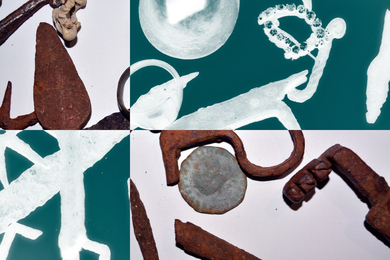Thirty undergraduates in Introduction to Archaeology (21.503) have been gaining first hand experience in archaeological method by excavating two sites behind MIT's venerable Building 20.
This year's dig was inspired by a series of intriguing items-fish skeletons, cow and cat bone, 19th century glass bottles, plates, nails, clay pipes, and shoe leather-unearthed by 21.503 students last year from the backdirt of the biology building excavations. Course instructors selected the Building 20 site on the advice of physical plant staff who, based on their extensive experience with campus digs, knew precisely where and at what depth artifacts tend to appear.
During February and March, most students carried out laboratory analyses of artifacts recovered in 1992. A small contingent researched the history of the MIT site. The aim of the laboratory projects was to identify methods used to manufacure bottles, nails, ceramics and other artifacts. Students approached the problem with characteristic ingenuity.
A shoe enthusiast found the oldest shoemaker in Cambridge, took him a selection of soles and the two determined how the shoes had been made.
Various materials science students studied their aritfacts (among them iron nails and horseshoes) in departmental laboratories identifying fabrication methods through artifact microstructure using standard metallographic techniques.
Students working on glass bottles, ceramics, and clay pipes were able to describe the general manufacturing histories of those artifact classes through library research. However since written descriptions of manufacturing methods often vary widely from actual practice, students next year will reconstruct manufacturing histories of ceramics and clay pipes using the more reliable methods of materials analysis (optical petrography). They also will investigate artifact chemical compositions through electron microprobe studies.
The group reconstructing MIT site history consulted documents and maps in the Institute Archives, the Cambridge Historical Society, and the Cambridge Public Library. They discovered that most of MIT sits on marshland that was filled about 1890. The fill consisted of material from local dumps, which explains the range of artifacts and materials recovered. Only a few buildings are shown that predate the construction of MIT, one of which was a carriage factory located at the corner of Main and Vassar streets.
Current excavations began at the end of March and are producing the same artifacts and materials found in the biology building backdirt, including whole bottles, nails, pipe fragments, ceramic and glass plates and shoe leather. Most date to between 1880 and 1910 although a few items are older. Iron carriage parts, horseshoes and slag are providing material evidence for the carriage factory shown on 19th century maps.
The course is co-taught by Professor Dorothy Hosler of the Center for Materials Research in Archaeology and Ethnology (CMRAE) and the Anthropology/Archaeology Program and Dr. Harry Merrick of the Anthropology/Archaeology Program. Professor Hosler also is a lecturer in the Department of Materials Science and Engineering; she specializes the prehistoric technologies of Mexico and Ecuador, especially ceramics and metal. Dr.Merrick is a specialist in African Prehistory and Human Evolution. Joan Merrick of the Anthropology/Archaelogy Program assists with the excavations and laboratory analyses.
The dig and laboratory exercises have generated sufficient enthusiasm that Hosler and Merrick have decided to incorporate excavations and materials analysis as a permanent feature of the class.
A version of this article appeared in the May 5, 1993 issue of MIT Tech Talk (Volume 37, Number 31).





